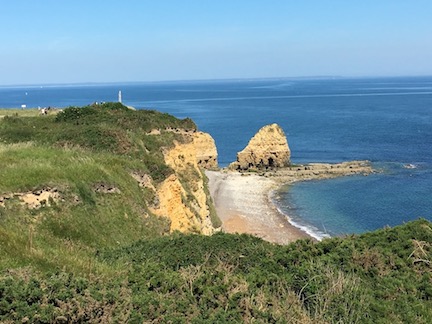
Greetings. We arrived home last week from our overseas trip and then I promptly got a bad cold from all the travels, which set me back longer than I expected, so I’ve been MIA from blogging for quite a while. Regardless, all went well while there and it was really a great learning and eye-opening experience visiting various World War I and World War II battle sites with a history group in northern France — emotional and stunning in various ways. My parents invited us on this trip so it was doubly special that we got to share it with them. It’s beautiful there too, and so much more peaceful now than those scary days when lives and freedom were on the line and devastation from bombs, automatic weapons and artillery rained down.
Being there — it wasn’t too hard to imagine those war days because if you’ve read some of the books and seen the movies and visited the museums along the route then pretty soon your mind becomes immersed and you can picture the soldiers in the woods, trenches, and on the beaches and it turns all very real even though World War I ended 100 years ago, and World War II was 73 years ago.
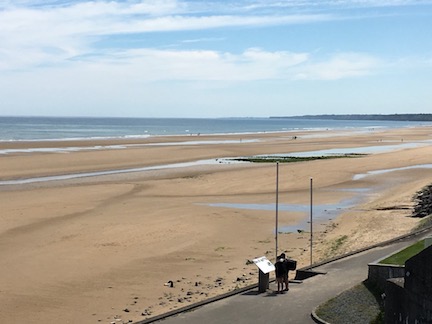
We visited the sites chronologically exploring the battle fields and memorials of World War I first, ending dramatically with where the 1918 Armistice was signed, then we moved on to World War II’s Normandy Invasion, tracking the route of the Allied Forces, until eventually the liberation of Paris, where we wound up the trip. I took some photos to share that I’ll probably continue to post here over the summer. At top is a picture of Pointe du Hoc overlooking the English Channel where U.S. Army Rangers landed and scaled the cliffs on D-Day — June 6, 1944. And just above is a shot of Omaha Beach at low tide, which took the greatest casualties during the Invasion of Normandy. Somewhere between 2,000 to 5,000 U.S. troops were killed, wounded, and missing at Omaha on June 6. There we walked down the beach quite a ways then scaled the bluff up to the American Cemetery and Memorial, where 9,387 American military dead are buried. Most were killed during the invasion and the military operations that followed.

German batteries such as this one at left were dug in along the coast and bluffs, and as the boats approached to within a few hundred yards of the shore, the troops came under increasingly heavy fire from automatic weapons and artillery. Miraculously by the end of the first day, the Allied Forces at the various landing beaches were able to gain a foothold in Normandy in spite of all that went wrong: the rough seas and weather conditions that threw them off and the ineffectiveness of the pre-landing bombing raids that apparently had done little or no damage to the German beach defenses, which inflicted heavy casualties to the men coming ashore. Oh what a terrible undertaking it all posed.
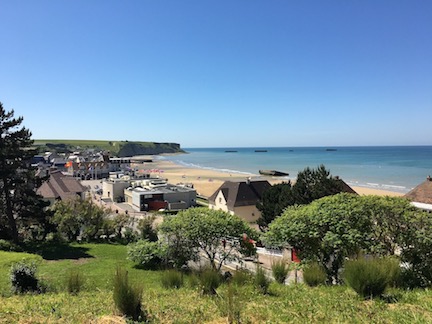
In addition to Omaha, we visited the beaches of Juno (the Canadian Army’s landing point), Gold and Sword (the British Army’s), and Utah (the U.S. Army’s), which made further inroads into gaining ground. Seeing them gave me a better perspective of what happened that day, as well as the museum exhibits we visited. Just the massive scale and logistical coordination of the whole Allied invasion still boggles my mind …. as well as the extensive temporary portable “Mulberry” harbors that were built by the Allies after D-Day to offload the tons of supplies and equipment that supported the troops. Apparently 1 truck every 7 seconds for 24 hours per day came ashore thanks to these structures. Above left, you can see the remnants of one such Mulberry harbor in the distance near the commune of Arromanches-les-Bains. I will post more in the coming weeks but for now I will leave you with a few reviews of what I finished lately.
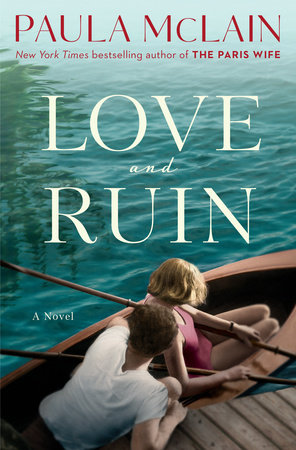
Ahh yes Paula McLain’s “Love and Ruin” — I knew I’d get to it. In fact, its ending I was reading came timely, right when I was in Normandy. For those who don’t know, it’s a fictional account of war correspondent Martha Gellhorn’s marriage to Ernest Hemingway (his third) from 1940 to 1945. Gellhorn was a trailblazing journalist of her day reportedly being the first journalist, male or female, to make it to Normandy on D-Day and report back and also among the first journalists to report from Dachau concentration camp after it was liberated by U.S. troops in 1945. Apparently Gellhorn was still covering conflicts around the world well into her 70s.
Of course, I was keen to snap up “Love and Ruin” as I had liked McLain’s earlier novel “Circling the Sun” about Beryl Markham. Though I was a little wary since two bloggers I trust — Carmen from Carmen’s Books & Movies Reviews and Catherine from the Gilmore Guide to Books — both had read and had criticisms of “Love and Ruin.” Hmm. Would it get a pan from me?
Admittedly the first part of the story I felt a bit asleep — during Martha Gellhorn’s upbringing and coming of age, even her stint covering the Civil War in Spain left me a bit ho-hem — but then somewhere around page 150 to 200 when she marries Hemingway, I sort of woke up. McLain seems to capture well the chemistry between the two famous writers … and then years later the erosion of it all. Theirs was a relationship that seemed quite intense and then sort of imploded. It just didn’t seem Martha could sit around and be solely Hemingway’s devoted, doting Wife —it was suffocating — she wanted her career too.
Perhaps my qualm with the novel was that towards the end it felt condensed … like Martha’s days of the London Blitz were quick and D-Day was just two pages, and the liberation of Paris was a flash — I could have used a bit more fleshed out here about what her times on the front lines of history were like and how they changed her — even her falling out with Hemingway. Still the parts it did include — especially about their relationship — I found pretty fascinating. McLain seems quite skilled at capturing the heart strings of a person. And maybe the last half of the book worked for me too because I was in Normandy right as I was reading about how Martha had snuck aboard the first hospital ship to land during D-Day. Wow she was there and helped with the wounded, while also documenting later what she had seen.
Granted, I was once the most skeptical person about reading McLain’s novels since they fictionalize the lives of such notable women icons. Just trying to “speak” for Beryl Markham, for example, seemed at first a total travesty to me — but then I read “Circling the Sun” and wasn’t put off by it. It seems McLain’s books sort of encourage readers to explore further such historical figures. They’re a bit of a surface overview at times but then I find you can revisit the sources’ works themselves. I’ve loved Markham’s books (“West With the Night” and her African Stories) and I still plan sometime to read the biography of Martha Gellhorn that Caroline Moorehead wrote, which Paula McLain relied on heavily for her novel. Gellhorn’s was quite a 20th-century life. I was happy to glimpse it even for a bit in this book.
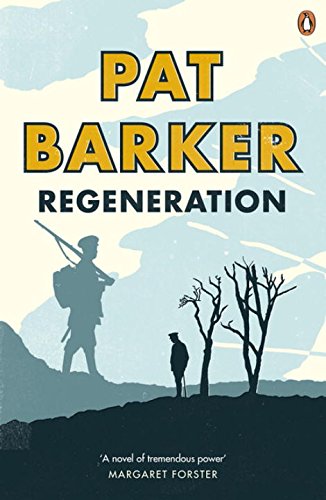
Next up, I finished Pat Barker’s 1991 novel “Regeneration,” which is set during World War I and is the first book in a trilogy. The story portrays quite vividly the plight of British army officers being treated for shell shock and trauma during WWI by a psychiatrist at a war hospital in Edinburgh. Dr. William Rivers is there to “cure” the soldiers and send them back to the front, but after a long duration while under a heavy workload, he becomes changed and comes to sympathize with the soldiers and their aversion to the war’s slaughter.
The somber mood and history of the story felt right on and I sympathized with the various characters — the doctor’s patients, primarily Siegfried Sassoon and Billy Prior, who have both experienced unfathomable horrors in the trenches and nightmares thereafter. Sassoon has gone as far as having written a public declaration against the continuation of the war, which lands him in jeopardy. All this is quite intriguing, though for some reason I never felt totally captured by the entire telling of the story. I was hoping to get more involved in it, or with the characters, but felt it wasn’t that easy a read. The novel jumps around a bit among the various characters and I found at times I was mixing up Siegfried Sassoon with Billy Prior, and then others like Burns are introduced and then aren’t heard from much again.
To me, Dr. Rivers is the most accessible and interesting character in the novel, and how he agonizes over the best way to treat these very damaged soldiers. Apparently he was a real person in history and much of his story told by Barker in this novel, along with that of patient Siegfried Sassoon, is true, which makes it a bit more compelling. Barker talks about their real lives in an Author’s Note at the end of the book. So while that and other parts of “Regeneration” were really strong, especially in its anti-war message — I felt it was a bit of an effort to wade through. Still I might someday like to read part 2 and 3 of this war trilogy to find out more about what happens to Dr. Rivers, Siegfried Sassoon and Billy Prior, who all go in various directions at the end of “Regeneration” — even one of them back to the War. Hmm. Will the telling of these sequels capture me a bit more?
That’s all for now. I have a couple of audiobooks’ reviews to post, but those can wait. I’ve talked too much already. I look forward to visiting your blogs again and to seeing what you’ve read lately.

Welcome back! Missed you so much. I almost always get sick after I travel. I thought I was just the wimp of all time. I am sorry to hear about your cold, but it made me feel less wimpy at least. Glad you are back in the swing.
Paula McLain. Oh dear. I read The Paris Wife and never went back. Glad to know there is a real biography of Martha Gelhorn. Adding that to my list.
Pat Barker is one of those authors I always want to read but never get to. Regeneration must have been pretty meaningful to read during your trip, even though it sounds like a slow burn. I recently read Blackout by Connie Willis, most of which is set during the Battle of Britain, so I was right there with you when you were describing some of the places you saw. You gave us an excellent travelogue!
Hi Judy! Missed you too & your wonderful blog. Glad you thought my travelogue was all right, thought some might be interested. I guess it was special b/c my parents had invited us, which I should mention in my post. It might be their last overseas trip. I was a bit shocked I got “the cold” — it had been awhile, darn. Still have the Kleenex box with me. It’s okay about not liking McLain. It’s not like I’m a huge fan; I’m just interested in her subjects (more). I did not read The Paris Wife. So is Blackout fiction? Would you recommend? I’m getting a little war’d out in my reading, but I will continue down the line.
Blackout is speculative fiction with time travel. Yeah, it might be too much war for you at this time.
Thanks Judy. I will look for your review of it.
Your trip sounds like a trip of a lifetime. My husband would really enjoy a trip like that. Sorry about the cold though. That always happens, doesn’t it?
Hi Ti, yes it was — it was a bucket list trip. But really b/c my parents invited us to go, which I should put in my post. It was nice to share it with them — as well as with my husband too. It was very special. Getting the cold when I got home – was a bummer! Ha, figures.
Sorry to hear about your cold. You had a very impressive trip. It is interesting that you visited the battlefields in chronological order. This, of course makes a lot of sense. I think that I mentioned this before, but matching your reading to your travels seems to be very enlightening. It is also a neat thing to do.
Thanks Brian. With your strong background in History — I think you would have really liked this trip. We really seemed to get a lot out of it — though with some of those huge museum exhibits I could’ve spent more hours in — but we didn’t have time to. We were on the go. Still it was awesome.
Welcome back, Susan! 🙂 Sorry for the cold. Your impressions of the trip are awesome. I would love to go on a tour like that! I like that it was a structured trip, visiting each site chronologically, along with museums and cemeteries. It must have been a sobering experience being right there and imagining it all as it happened, learning the staggering amount of soldiers that fell in those beaches.
Thanks for shout out! 😉 As you know, I wasn’t crazy about Love and Ruin. It’s possible that reading it during your trip, or so close to it, enhanced the experience of it. I wish that I had liked Martha Gellhorn because it seems that she was a trailblazer but I didn’t get that image from McLain. It would be interesting to read her biography to see if it does the woman justice, not so much “what she did” but “who she was”, what made her tick.
Hey Carmen, thanks for your comments as always. You would have liked the trip. It was a bucket list itinerary — an organized history trip that my parents invited us on. The cemeteries were staggering, all the young guys from 17 to 20 years old. Some of the places really gave me a feeling — of what happened. As for McLain, I respect your thoughts on her book. I still feel like I want to know Gellhorn more; she’s still somewhat shady or illusive to me — after the book. Maybe the biography will help.
Your trip sounds wonderful. I imagine it was chilling visiting some of those sites. I wasn’t keen on Circling the Sun so I’ll probably skip Love and Ruin.
Thanks Kathy, yes, visiting some of the battle sites and cemeteries was quite eerie, but I was glad to pay my respects and see these areas for myself. I don’t think McLean’s books are all that appealing unless one is really interested in the women she writes about. Hmm, just a feeling.
I’ve read and enjoyed several Paula McLain books: The Paris Wife, A Ticket to Ride, and Growing up in Other People’s Houses, a book that resonated with me. Her story took me back to my social work days, and while my path did not cross with hers, we were almost on a parallel course: Here’s my review: https://www.goodreads.com/review/show/43945078?book_show_action=false&from_review_page=1
As you know, I was set to read Love & Ruin…and then got overwhelmed with other library books. I’ll be checking it out again.
Thanks for visiting my blog, and enjoy settling in at home.
Hi Laurel, thx for the link to your review of McLain’s memoir book. It’s amazing to me how successful she is — despite the hard youth she had in foster care homes. I’d like to read that one. Kudos to her, for overcoming such adversity etc. I hope you like her new book … I thought the 2nd half of the book the best. Cheers.
I love your thoughts on Love & Ruin. I actually liked it quite a lot, but you’re so right that more on Gellhorn’s coverage of the end of WWII would have been welcome. She truly was an amazing woman, well ahead of her time. I also enjoyed Circling the Sun, but my favorite Paula McLain book is The Paris Wife. Have you read that one? It covers EH’s first wife, Hadley Richardson, and their time in Paris between the wars. I highly recommend it if you haven’t yet read it.
Your trip looks fabulous. It’s nice to get a real picture of all the spots we read about in books about the World Wars.
Thanks Susie! Seeing the WWI & II sites made it more real to me. It was great, my parents invited us & it was a nice trip to share together. I did not read McLain’s first book The Paris Wife, but I think I should get to it. I’m a bit impressed with McLain. Her heart seems in the right place. Apparently Gellhorn was the only woman to leave Hemingway … hmm. Thx for the tip on which one you liked best.
Welcome home. Hope you are regaining your health quickly. I loved CIRCLING THE SUN. I wonder if I would like LOVE and RUIN?
Hi Anne: I think if you liked Circling the Sun then you will probably like Love & Ruin. There’s similarities in the telling of it. Similar style, and similar strong & ambitious women. Check it out. Enjoy.
Welcome back! Sorry you got sick right after getting home, that’s always the worst. Sounds like a great trip, though, with lots of interesting sites.
Yes thanks Kim, it really was. The whole trip really captured me and I still find myself thinking about it. I think I will for the rest of the summer! Thx for stopping by.
Welcome back! I loved hearing about your travels, and seeing the pictures. It’s terrible to think that those beautiful places were once scenes of horror.
I read about Martha Gellhorn briefly in Naomi Wood’s Mrs. Hemingway, but I found it too brief to really get a feel for her. Her life sounds so interesting – I’d like to learn more about her career. When I was reading Mrs. Hemingway, my big question was why was such a smart, independent woman falling for Hemingway? Maybe this book explains it a bit better.
Hi Naomi, thanks for your comments. Good question about Gellhorn. I think she had her doubts going into the Hemingway marriage. At least that’s how it’s portrayed in McLain’s book. But she got smitten with him in Spain when they were both wartime journalists. They were on the frontlines together & got involved. She admired his writing too. I still need to find out more about Gellhorn to really get a feeling of what she was like. Reading the biography of her by Caroline Moorehead would give me a better idea.
So much to absorb from this post! First of all, what an amazing trip. And it looks like you had perfect weather. I’m looking forward to seeing and hearing more about it.
I was interested to hear you mention WWI because I recently read a novel, The Verdun Affair, that dealt solely with the aftermath of the war- specifically in Verdun France. Over 1 million men died in that battle! I’m embarrassed because I had no idea. My sense is you were in northern France and this was southern France.
I thought Gellhorn’s D-Day experience was fascinating. I can’t imagine that kind of bravery. It definitely left me wanting to learn more about her.
Excellent Catherine. I had seen the novel the Verdun Affair but had read some mixed reviews on Goodreads. Did you like it? I will visit your site to find out. It seems like Verdun is near the border with Belgium & Germany in the NE. Unfortunately we did not get that far East. We were sort of more to the NW on our recent travels. If you recommend the Verdun Affair, I will read it. I’m still very caught up in trying to understand WWI. The casualties are totally staggering. I would also like to find out more about Gellhorn. McLain’s novel, while interesting, doesn’t totally capture all of her …. hmm